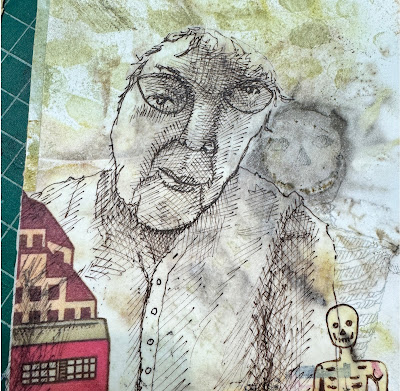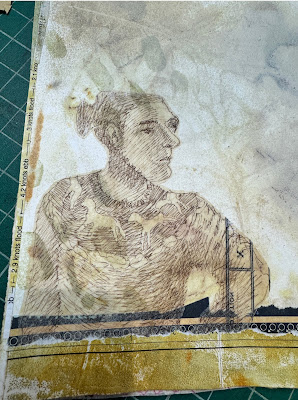 |
| Fluke, 1987. 7 x 5 x 1 inch closed. Collage and acrylic paint on watercolor paper. |
I have been anticipating this class for months. Originally I thought I could write one really good statement and cross that off my to-do list. It's not that easy. Jane suggests a new statement for every new body of work. Or maybe every 6 months. It does make sense. As we look at what makes a good statement I realize I would need to re-write it every time my work changes. With Jane's guidance we dug into ourselves and tried to explain what was important to us about making art. It was hard work, I usually just write whatever comes into my head. I ended up with 17 pages of text and notes. And three paragraphs that work well.
 |
| Duck Dreams, 1987, 7 x 5 x 1 inch closed. Collage on watercolor paper, acrylic paint. |
At one point I went back and looked at all my earliest books to try to explain why the book format was so important to me. I think my interest in artist's books goes way back to a text book for an art class I took around 1965. There was a photo of a handmade book that had a glove stitched to one page and a ladder on the opposite page. This whole book as a revelation - it had a lot of art that I would not have defined as art. And I loved a lot of it. It was eye opening. I figured out which book it was and ordered a used copy. I'm very curious to see that again.
 |
| In My Dreams We Travel in Boats, 2008. |
So far I have 17 pages of rumination. Out of that has come a statement that feels authentic to me, it's certainly the best one I have ever written. I have learned more about myself, and I know more now about what I want to say in my art. I would definitely recommend this class to people who are willing to put in the work. It's like a college level class, with time consuming homework. But it only lasted 5 weeks, with more time to discuss for another 3 weeks. The more time and effort you put in, the more you will get out of it.
 |
| Fluke, 1987, 7 x 5 x 1 inch closed. One of my favorite early books. |
I wanted to take the time to look closely at everyone else's work and writing and try to respond to it. Partly because I don't feel I'm very good at looking at art in general. And I'm often not able to articulate what I feel about it. As people's statements came into focus they helped me to see their art in a new light. I had never realized how important and helpful a good statement could be.
And here is the statement:
Dreams have been a major interest all my life. When I was around eight I had a dream that terrified me. Little creatures were quickly lifting me up in the air, my family was far below, calling and reaching up to me. But the creatures carried me higher and higher, I couldn’t get away. I woke terrified, I had the feeling that dreaming was another world, as real as our “waking” world. I did not want to go back there for months.
I have kept a dream journal off and on since I was in my 20’s. When I went to art school in my 30’s I became consistent, and started using the dreams as inspiration. When I’m dreaming I can draw aside a curtain in my mind and see more of what’s going on there. I don’t understand most of my dreams. I always write them in the first person present tense and end with “I wake.”
Books hold stories and are the perfect containers for dreams. They can be held in my hand, pages are turned, the images are sequential and so influence each other more. Books feel personal. I believe books can contain answers to all the big questions, where did I come from when I was born? Where will I go when I die? I just have to find or make the right book.


























